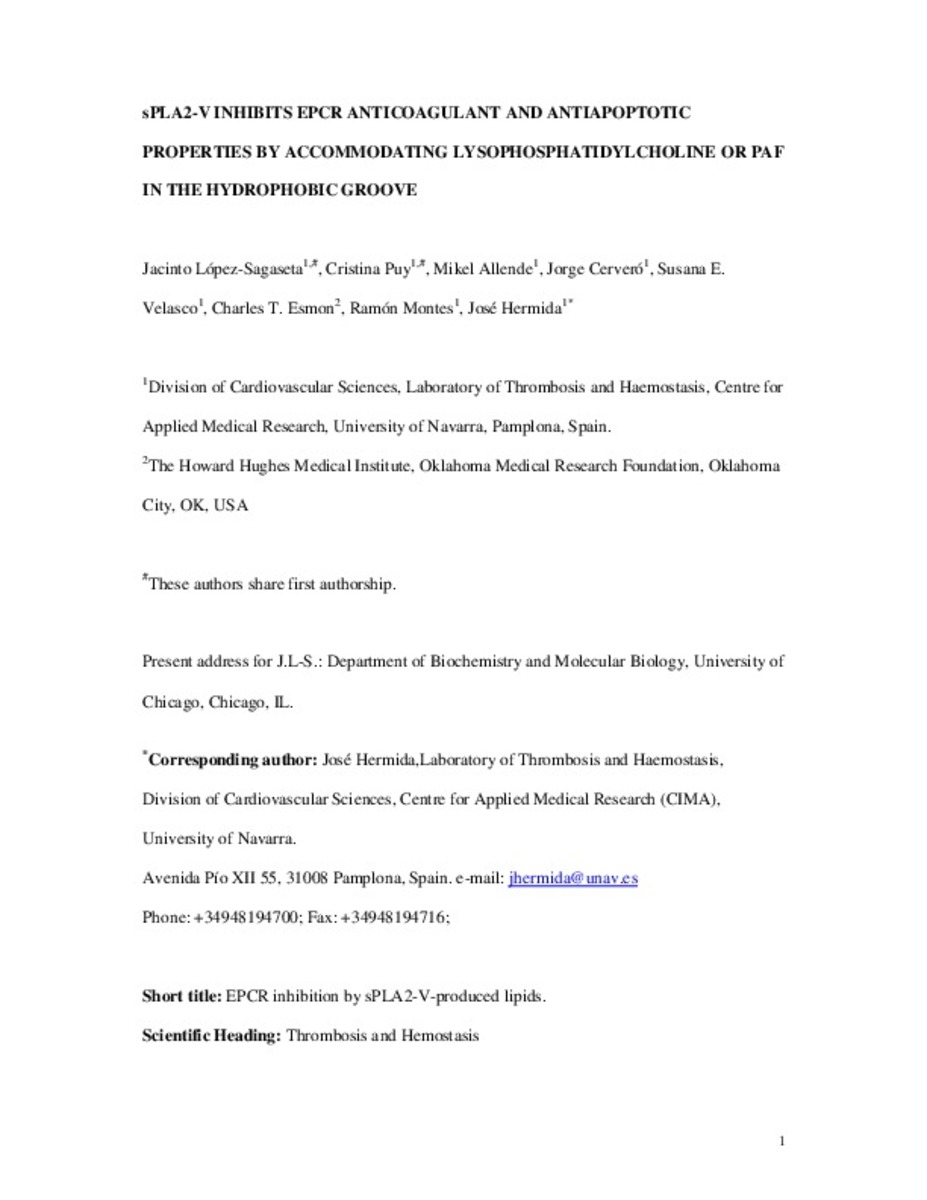Full metadata record
| DC Field | Value | Language |
|---|---|---|
| dc.creator | Lopez-Sagaseta, J. (Jacinto) | - |
| dc.creator | Puy, C. (Cristina) | - |
| dc.creator | Tamayo, I. (Ibai) | - |
| dc.creator | Allende, M. (Mikel) | - |
| dc.creator | Cervero, J. (Jorge) | - |
| dc.creator | Velasco, S.E. (Susana E.) | - |
| dc.creator | Esmon, C.T. (Charles T.) | - |
| dc.creator | Montes, R. (Ramón) | - |
| dc.creator | Hermida, J. (José) | - |
| dc.date.accessioned | 2012-03-13T16:08:32Z | - |
| dc.date.available | 2012-03-13T16:08:32Z | - |
| dc.date.issued | 2012 | - |
| dc.identifier.citation | Lopez-Sagaseta J, Puy C, Tamayo I, Allende M, Cervero J, Velasco SE, et al. sPLA2-V inhibits EPCR anticoagulant and antiapoptotic properties by accommodating lysophosphatidylcholine or PAF in the hydrophobic groove. Blood 2012 Mar 22;119(12):2914-2921. | es_ES |
| dc.identifier.issn | 1528-0020 | - |
| dc.identifier.uri | https://hdl.handle.net/10171/21133 | - |
| dc.description.abstract | The endothelial protein C receptor (EPCR) plays an important role in cardiovascular disease by binding protein C/activated protein C (APC). EPCR structure contains a hydrophobic groove filled with an unknown phospholipid needed to perform its function. It has not been established whether lipid exchange takes place in EPCR as a regulatory mechanism of its activity. Our objective was to identify this phospholipid and to explore the possibility of lipid exchange as a regulatory mechanism of EPCR activity driven by the endothelially expressed secretory group V phospholipase A2 (sPLA2-V). We identified phosphatidylcholine (PCh) as the major phospholipid bound to human soluble EPCR (sEPCR). PCh in EPCR could be exchanged for lysophosphatidylcholine (lysoPCh) and platelet activating factor (PAF). Remarkably, lysoPCh and PAF impaired the protein C binding ability of sEPCR. Inhibition of sPLA2-V, responsible for lysoPCh and PAF generation, improved APC binding to endothelial cells. EPCR-dependent protein C activation and APC antiapoptotic effect were thus significantly enhanced. In contrast, endothelial cell supplementation with sPLA2-V inhibited both APC generation and its antiapoptotic effects. We conclude that APC generation and function can be modulated by changes in phospholipid occupancy of its endothelial cell receptor. | es_ES |
| dc.language.iso | eng | es_ES |
| dc.publisher | American Society of Hematology | es_ES |
| dc.rights | info:eu-repo/semantics/openAccess | es_ES |
| dc.subject | Endothelial cell protein C receptor | es_ES |
| dc.subject | Secretory group V phospholipase A2 | es_ES |
| dc.subject | Phosphatidylcholine | es_ES |
| dc.subject | Lysophosphatidylcholine | es_ES |
| dc.subject | Platelet activating factor | es_ES |
| dc.title | sPLA2-V inhibits EPCR anticoagulant and antiapoptotic properties by accommodating lysophosphatidylcholine or PAF in the hydrophobic groove | es_ES |
| dc.type | info:eu-repo/semantics/article | es_ES |
| dc.relation.publisherversion | http://bloodjournal.hematologylibrary.org/content/early/2011/12/13/blood-2011-05-353409 | es_ES |
| dc.type.driver | info:eu-repo/semantics/article | es_ES |
Files in This Item:
Statistics and impact
Items in Dadun are protected by copyright, with all rights reserved, unless otherwise indicated.






